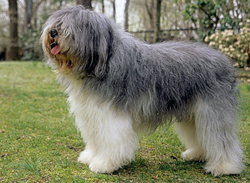Polish Lowland Sheepdogs are medium-sized dogs with long, straight, shaggy coats that hang over the eyes. Coat colors include gray with white, solid chocolate, and white with black, sandy, or gray patches. The outer coat is water resistant, and the under coat is dense and soft. These dogs have medium-sized eyes that are brown and oval. They also have heart-shaped ears and large, dark noses. Polish Lowland Sheepdogs measure 17 to 20 inches tall at the shoulder and weigh 35 to 55 pounds.
Energetic and cheerful, these dogs are a lot of fun to be around. They are devoted to their human family members, but tend to be suspicious and aloof around strangers.
Affectionate and loving, Polish Lowland Sheepdogs are a good choice for families with children. These dogs fit into all lifestyles and can adapt to most living situations. They make good watchdogs, but their possessive nature leads them to steal things.
The Polish Lowland Sheepdog is known its native Poland as Polski Owczarek Nizinny, or "PON." These dogs are very popular in Poland and their image can even be found on stamps. Polski Owczarek Nizinny is pronounced pole-skee ahv-cha-rek ni-gi-nee.
Polish Lowland Sheepdogs are intelligent, fearless, protective, and lively dogs that have a strong desire to please. They are known for their superior memories and independent natures, and they can be silly or goofy at times. These dogs do well with older children; they may be too rambunctious for younger kids.
Energetic and cheerful, these dogs are a lot of fun to be around. They are devoted to their human family members, but tend to be suspicious and aloof around strangers. PONS make excellent watchdogs, but they aren't the best guard dogs. Still, they will bark to warn of approaching strangers and their loud voice can be intimidating.
As great as they are, these dogs are not all fun and games. They tend to be possessive and may steal and hide objects from around the house. They also require a lot of physical and mental stimulation and daily exercise to help keep away negative and destructive behaviors that result from boredom and restlessness. Organized dog sports, such as herding, obedience, and agility, are a great way to keep these dogs busy.
Polish Lowland Sheepdogs are one of the more healthy dog breeds, but this is not a guarantee that any individual dog will be free of serious illness or genetic problems. Purchasing or adopting one of these dogs from a reputable source goes a long way toward ensuring a long and healthy life.
Conditions known to occur in the breed include congenital hip dysplasia, hypothyroidism, and neuronal ceroid-lipofuscinosis. Progressive retinal atrophy, an eye condition that can lead to blindness, is also seen in Polish Lowland Sheepdogs.
Polish Lowland Sheepdogs typically live up to 12 years, provided they have access to a healthy diet, regular activity, and routine veterinary care.
It's important to start training the Polish Lowland Sheepdog early in life. These dogs are independent by nature and tend to be stubborn. They need consistent training and an experienced, dominant trainer.
Fortunately, these dogs learn quickly and respond well to positive reinforcement techniques, such as praise, play, and food rewards. Kindness helps too; PONS don't take well to harsh criticism or punishment. Rules should be established right away that forbid pulling on the leash, barking excessively, and ignoring commands.
Stealing and other problem behaviors will usually improve over time, provided training is consistent and rewards are offered for doing what is appropriate. The breed's herding instinct is natural, but that doesn't mean the Polish Lowland Sheepdog should be allowed to herd children or nip at their heels.
Polish Lowland Sheepdogs need a good amount of grooming to keep their coat and skin healthy. The breed's coat should be brushed daily to prevent mats and tangles. A natural bristle brush works well, followed by a careful combing. It's important to get all the way down to the skin; otherwise, deep mats may develop. The good news is that these dogs shed very little.
Monthly baths are beneficial to remove dirt and odor from the breed's coat. It's also essential to regularly check and clean the feet, as they tend to collect dirt and other debris. Regular shampooing with a pH-balance product will provide sufficient cleaning without causing irritation.
The breed's nails should be clipped every couple of weeks; they should never be allowed to grow so long as to click against the floor. The teeth need brushing daily to prevent tartar buildup and protect against gum disease, and the ears should be examined for signs of infection and then cleaned once weekly with a veterinarian-approved otic cleanser and cotton balls.
Polish Lowland Sheepdogs descended from coated working dogs in Central Asia, such as the Lhasa Apso and Tibetan Terrier. The Tibetan people were ardent traders and would have brought their dogs with them when traveling across Asia and Europe. There, the PON would have mixed with local working dogs.
PONs can be traced back to before the 16th century in Poland, where they were used primarily to herd and guard. The breed also contributed to the development of Scotland's Bearded Collie after a Polish ship picked up a Scottish cargo containing sheep. The Polish traded three PONs for a ram and ewe in 1514.
Today, the breed is primarily kept as a companion animal in the United States. They are beloved for their lively and protective personalities.
The American Kennel Club didn't officially recognize the Polish Lowland Sheepdog until 2001.

